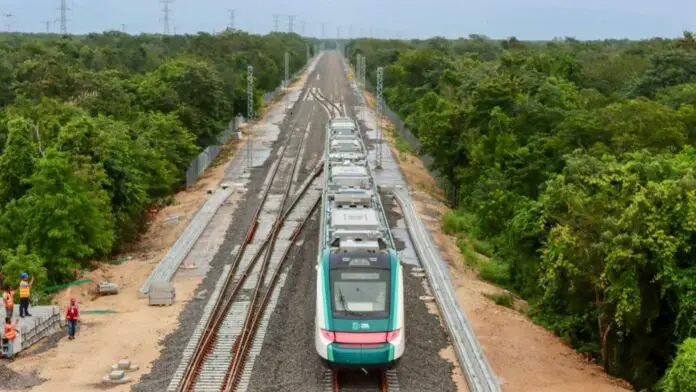A month before its inauguration, the National Defense Secretariat (Sedena) acknowledged this Tuesday that more than 68 percent of the Section 5 North of the Maya Train -which goes from Cancún to Playa del Carmen, in Quintana Roo- was built on soil with “high karsticity”. Karsticity is a phenomenon caused by the humidity of the subsoil that causes the dissolution of the limestone rock, causing holes, sinkholes and even collapses.
Blas Núñez Jordán, head of the Operations Coordination Center (CCO) of the Maya Train, admitted that 29.7 of the 43.3 kilometers of the Section 5 North of the Maya Train required the construction of an elevated viaduct of reinforced concrete, right on that type of soil with “high karsticity”.
“It is a double electrified track, planted on 29.7 kilometers of elevated viaduct structure of concrete, reinforced, 12 to 5 meters high, on natural terrain, built to support the weight of the Train, attenuating damage to the soil, with a presence of high karsticity”, he said.
The military also acknowledged that the Puerto Morelos station is built on the elevated viaduct and that, due to the soil conditions, the execution of the work is “challenging”.
“For its construction it was necessary to carry out various geological, geophysical, geotechnical, hydrological studies, geo exploration campaigns, in addition to a challenging work execution program, coordinated with a meticulous strategic supply program that allowed in 19 months to carry out planning, project and construction activities”.
The military indicated that the other 13.6 kilometers of the Section 5 North of the Maya Train are planted on a platform of embankment, “on soils of low karstic commitment”.
According to the National Center for Disaster Prevention (Cenapred), karsticity can generate risk situations for those who live in these areas.
Mexicans against Corruption revealed that internal reports from the Sedena, hacked in 2022 by the collective Guacamaya, warn that, due to the instability of the soil in the area, there is a severe risk of sinkholes and collapses in Section 5 of the Maya Train, which goes from Cancún to Tulum; in its files, it acknowledges that only in that section it has cut down an area equivalent to 11 zocalos.
A report dated August 22, 2022 includes a map that identifies “zones of severe karstic risk” in much of the northern section.
It should be noted that Section 5 of the Maya Train is built in an area where caves and underground rivers abound, which are responsible for the recharges of the aquifer of the Maya region.
This report was addressed to General Óscar David Lozano Águila, identified as responsible for the Maya Train company, and sent to the head of Fonatur, Javier May.
The inauguration
The section 5 north of the Maya Train, which goes from Cancún to Playa del Carmen, in Quintana Roo, will be inaugurated next Thursday, February 29 with 50.157 kilometers of double electrified track, reported the general director of the company Tren Maya S.A. de C.V., Óscar David Lozano Águila.
In the third stage of inauguration of this project there will be six daily departures.
From Cancún Airport to Playa del Carmen
9:00 hours
12:00 hours
15:00 hours
From Playa del Carmen to Cancún Airport
10:30 hours
13:30 hours
16:30 hours
In all departures you will pass by the Puerto Morelos station in both directions.
Minibuses without environmental impact study
In addition, together with section 5 North of the Maya Train, the electric minibus system that will connect the passengers of the Cancún International Airport with the railway station will also start operating.
Source: La Silla Rota







